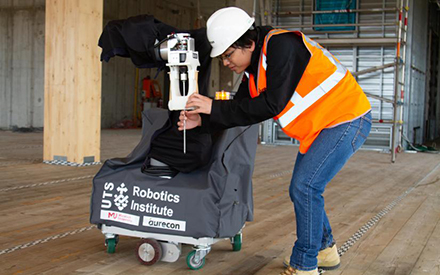
UTS researcher Dinh Dang Khoa Le fits a screw into QUENDA-BOT’s arm while trialling the technology on a construction site. Photo supplied by Murdoch University.
A world-first robotics technology has been trialled on a construction site in Perth demonstrating the vast potential of mass timber building projects. It’s a power drill, but not like one you’d find in the local hardware store. Source: Timberbiz
QUENDA-BOT is a robot uniquely designed by the University of Technology Sydney (UTS) researchers Dikai Liu, Liang Zhao, Shoudong Huang, Gibson Hu, Richardo Khonasty and Dinh Dang Khoa Le. It is designed to deliver cumbersome screw fixings. This task can cause fatigue and injury in workers given the repetitive and labour-intensive nature of this work, especially on mass engineered timber (MET) construction projects.
“This work is ideal for a robot,” said Professor Shoudong Huang, Deputy Director of the UTS Robotics Institute.
“Robots can insert the screws more accurately and apply more consistent force and control to the drill than a human. This type of innovation in construction technology has the potential to revolutionise the construction of timber structures.”
Distinguished Professor of the UTS Robotics Institute Dikai Liu said intelligent robots, like QUENDA-BOT, are able to navigate complex and changing construction sites to conduct key operations, such as drilling a screw into the correct position.
“What we have been able to design is an intelligent robot that can focus on an important task even amidst this disruptive environment,” said Professor Liu.
QUENDA-BOT builds on technology developed by the UTS Robotics Institute over a number of years, including its robots for Sydney Harbour Bridge inspection and maintenance, its robot for underwater structure maintenance, and a robot for surgery.
“Some techniques are common to the different applications, but some of the techniques are unique to the specific applications,” said Professor Huang.
The world-first robotics technology is part of a collaboration between UTS, Murdoch University and international design, engineering and advisory company Aurecon.
The ability for QUENDA-BOT to be tested on a live construction site has implications not just for the partners involved, but also for the broader industry.
Aurecon’s Managing Director, Built Environment Australia, Tim Spies, said the pilot project showed that by thinking more innovatively, the timber industry could lead the way in improving construction project outcomes.
“The long-term objective is to prove that the modular nature of timber construction will benefit from the automation of some on-site construction activities, helping to increase productivity, reduce cost, improve workers’ OH&S, and advance innovation in the construction industry,” said Mr Spies.
There are around 200,000 to 300,000 screw fixings on the Building 360 construction site and the robot was trialled installing approximately 50 to 100 fixings as part of the proof of concept.







